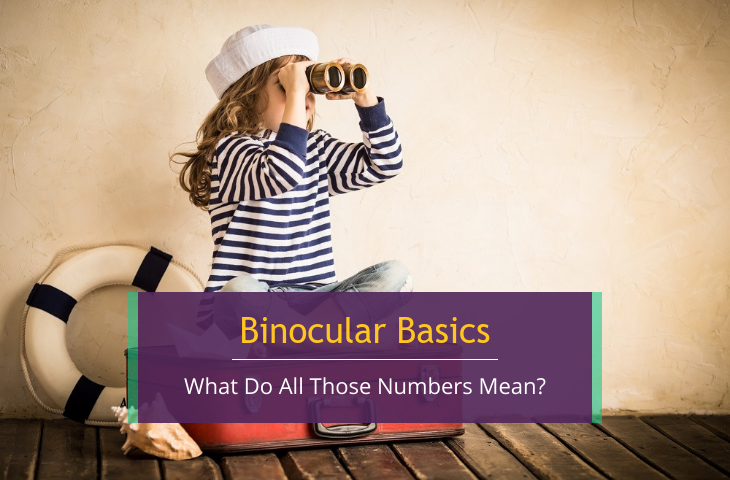If you are new to binoculars, all the different terms and numbers can get confusing. This post provides a great beginner guide to help you understand what things like magnification, aperture, eye relief, exit pupil, close focus, and field of view mean.
And more importantly, why they matter!

“Dwell on the beauty of life. Watch the stars, and see yourself running with them.”
- Marcus Aurelius -
Summertime and fall are perhaps the best time of year to invest in a pair of binoculars.
Whether you plan to use binoculars for birding, a trip into the safari to spot the lions and elephants or just for taking a closer look at the world around you, you can be sure that a pair of binoculars is a great purchase.
Using binoculars can be a bit of a challenge, however, and there is definitely a learning curve to overcome while using them. Whether you are struggling to look through them properly or adjust them to your liking, there are lots of fiddly bits to deal with.
One facet of binoculars that fascinates (or should we say confuses?) many are the small numbers that appear on the binoculars themselves and also in the eyepieces.
Understanding what these numbers mean is imperative to having a great experience with your first pair of binoculars. Let's take a look at the most important numbers you need to know when buying a new pair of binoculars.
Related: Best Bushnell Binocular Reviews
What are Magnification Numbers and Aperture?
The first numbers you will come across on a pair of binoculars are the magnification numbers. These magnification numbers are always expressed in a combination of two numbers, like 8 x 40 or 10 x 25 for example.
The first number in this pair describes the power of the magnification. For instance, binoculars with 10x magnification will make objects appear 10 times closer than they are in reality.
Binoculars with more than 12x magnification make it difficult to maintain a steady image during use. If you plan to get binoculars with an extreme magnification, keep in mind that you will have to use them on a stabilized platform like a table or a wall. Another option is to get zoom binoculars that feature an adjustable magnification range.
The number following the magnification number is the objective lens size, which is more commonly known as the aperture. The aperture shows how much light the lenses in the binoculars are able to take in.
For example, a 10 x 50 binocular will have a 50 mm objective lens. The wider the lenses, the larger the pair of binoculars will be.
Larger aperture numbers are imperative if you plan to use your binoculars at night or in other low light conditions.
Binocular Basics: What Do the Numbers Mean?
Knowing what the numbers mean can help you make the best choice. | Courtesy of Cornell Lab of Ornithology
What is Angle of View in Binoculars?
In order to properly utilize your new binoculars, you first have to understand the concept of angle of view. The angle of view refers to the amount of horizontal scenery that can be seen when using the binoculars.
The angle of view is always discussed in terms of degrees. The higher this number is, the wider an area you will be able to see through your binoculars. Any number higher than 6 degrees is considered a decent angle of view.
What is a Binocular Field of View?
Another concept that you must grasp before using your binoculars is field of view. Unlike angle of view, field of view is expressed in feet per 1000 yards or meters per 1000 meters instead of degrees. This concept still refers to how much scenery you are able to take in while using your binoculars.
A field of view of about 300 to 375 feet is decent for most activities. Keep in mind that the higher your magnification, the smaller your field of view will be because of the object being brought closer to your eye through the lens.
What Does Eye Relief Number Mean?
The eye relief number is only of interest to you if you wear glasses. This particular number tells the user how far away the eyepiece can be from your eyes while during use.

What is an Exit Pupil Number?
When dealing with the exit pupil number, bigger is typically better. The most simple way to understand this number is to hold your binoculars about 8 inches from your eyes. The two dots that you can see in the center of the lenses are where the light hits your eyes in order to display the image.
The area around these dots need to be larger than your pupils. This particular number is calculated by dividing the lens diameter with the magnification.
What Does Close Focus Mean with Binoculars?
The close focus number lets the user know the minimum distance the binoculars need to be from an object in order to focus on it. For example, if the close focus for a pair of binoculars is 12 feet, this means you can perfectly focus on an object as long as it is at least 12 feet away from you.
A Few Final Words…

Once you understand all of the different numbers that come on a pair of binoculars, you will be able to use them to their fullest capacity. It may be tempting to take your new binoculars out for a spin before you become an expert but studying up on these few details can make every excursion that much more memorable.
We hope you have enjoyed this article and it has given you enough information to go out and find the best pair of binoculars for your needs.
If you're not ready yet, we also have a more in-depth buying guide and an article about how to adust binoculars for a clear view.
